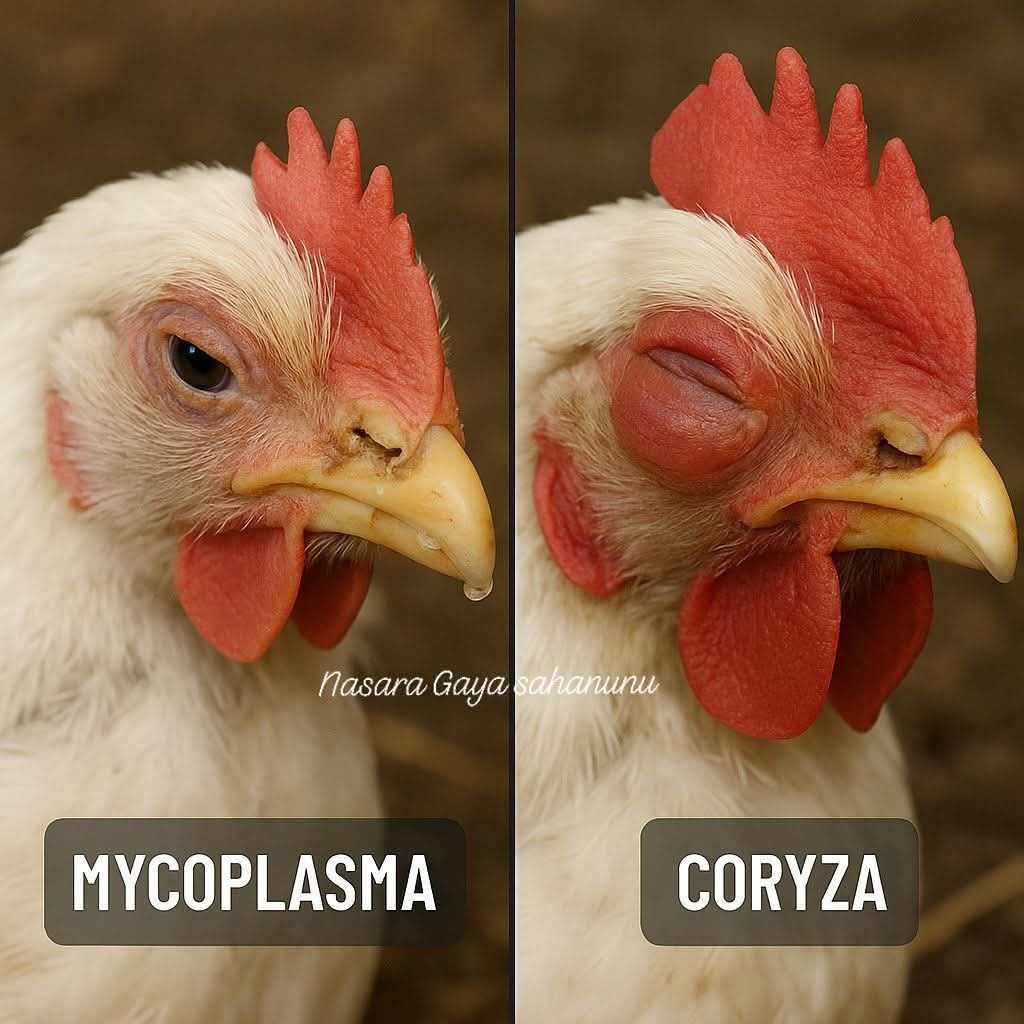MYCOPLASMA & CORYZA?
Know the Deadly Difference Before It's Too Late
Here’s a clear explanation of the two diseases shown in the picture:
1. Mycoplasma (Mycoplasma Gallisepticum)
How It Affects Chickens
Attacks the respiratory system.
Spread through air, direct contact, or from infected parents to chicks.
Stress, poor ventilation, or co-infections can worsen the disease.
Symptoms
Watery eyes
Nasal discharge
Sneezing
Swollen sinuses
Drop in egg production
Treatment
Use antibiotics like Tylosin, Tylvalosin, or Doxycycline (consult a vet).
Isolate sick birds.
Improve ventilation and reduce stress.
Biosecurity to prevent spread.
2. Coryza (Infectious Coryza)
How It Affects Chickens
Caused by bacteria Avibacterium paragallinarum.
Spreads through contact, contaminated water, or feed.
Very contagious, especially in wet, crowded conditions.
Symptoms
Swollen face and eyes
Foul-smelling nasal discharge
Difficulty breathing
Reduced appetite and egg production
Treatment
Use antibiotics like Sulfa drugs (e.g., Sulfadimethoxine) or Erythromycin.
Quarantine infected birds.
Clean and disinfect the coop.
Practice strict biosecurity.
Prevention Tips for Both
Avoid overcrowding
Provide clean water & feed
Vaccinate if available
Quarantine new birds
Practice good hygiene
Know the Deadly Difference Before It's Too Late
Here’s a clear explanation of the two diseases shown in the picture:
1. Mycoplasma (Mycoplasma Gallisepticum)
How It Affects Chickens
Attacks the respiratory system.
Spread through air, direct contact, or from infected parents to chicks.
Stress, poor ventilation, or co-infections can worsen the disease.
Symptoms
Watery eyes
Nasal discharge
Sneezing
Swollen sinuses
Drop in egg production
Treatment
Use antibiotics like Tylosin, Tylvalosin, or Doxycycline (consult a vet).
Isolate sick birds.
Improve ventilation and reduce stress.
Biosecurity to prevent spread.
2. Coryza (Infectious Coryza)
How It Affects Chickens
Caused by bacteria Avibacterium paragallinarum.
Spreads through contact, contaminated water, or feed.
Very contagious, especially in wet, crowded conditions.
Symptoms
Swollen face and eyes
Foul-smelling nasal discharge
Difficulty breathing
Reduced appetite and egg production
Treatment
Use antibiotics like Sulfa drugs (e.g., Sulfadimethoxine) or Erythromycin.
Quarantine infected birds.
Clean and disinfect the coop.
Practice strict biosecurity.
Prevention Tips for Both
Avoid overcrowding
Provide clean water & feed
Vaccinate if available
Quarantine new birds
Practice good hygiene
💥MYCOPLASMA & CORYZA? 💥
Know the Deadly Difference Before It's Too Late
Here’s a clear explanation of the two diseases shown in the picture:
1. Mycoplasma (Mycoplasma Gallisepticum)
💥How It Affects Chickens💥
✅Attacks the respiratory system.
✅ Spread through air, direct contact, or from infected parents to chicks.
✅ Stress, poor ventilation, or co-infections can worsen the disease.
Symptoms
✅ Watery eyes
✅Nasal discharge
✅Sneezing
✅Swollen sinuses
✅ Drop in egg production
Treatment
✅ Use antibiotics like Tylosin, Tylvalosin, or Doxycycline (consult a vet).
✅ Isolate sick birds.
✅Improve ventilation and reduce stress.
✅Biosecurity to prevent spread.
2. Coryza (Infectious Coryza)
💥How It Affects Chickens 💥
✅ Caused by bacteria Avibacterium paragallinarum.
✅Spreads through contact, contaminated water, or feed.
✅Very contagious, especially in wet, crowded conditions.
Symptoms
✅Swollen face and eyes
✅Foul-smelling nasal discharge
✅ Difficulty breathing
✅Reduced appetite and egg production
Treatment
✅Use antibiotics like Sulfa drugs (e.g., Sulfadimethoxine) or Erythromycin.
✅Quarantine infected birds.
✅Clean and disinfect the coop.
✅Practice strict biosecurity.
Prevention Tips for Both
✅ Avoid overcrowding
✅ Provide clean water & feed
✅ Vaccinate if available
✅ Quarantine new birds
✅ Practice good hygiene





